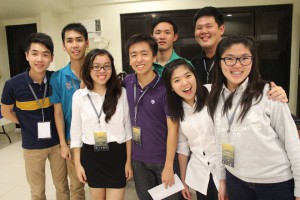Article by Nathan Chan and Matt Frederic See
Edited by Patrick Ang and Aaron S. Medina
Photos by Jerry Feng
In Luis Katigbak’s Birthday, the protagonist stands in the rain, unaware of what he is doing and who he is. Convicted by his conscience of the repercussions of his trade, he throws away his identity, feigning innocence.
One insight gleaned from the story is that people are all, in one way or another, like the unnamed protagonist. In an increasingly compressed world with different cultures interacting, one may lose sight of his or her original identity, shaped by the socio-cultural and political milieu of the time. When this happens, the values and perspectives that orient their identity become meshed, confounded, and altogether disjointed.
This is the case for Chinese-Filipinos when it comes to filial piety.
Typical notions of filial piety that may have been guided by misconceptions abound. These notions include “doing what needs to be done”, “caring for one’s parents to the best of one’s abilities”, and “keeping the heritage intact through acts of obedience and taking responsibility in upholding family traditions”.
Values, cultures, and ideas develop overtime without prior knowledge of their growth. While potentially a factor for the fluidity in communications, globalization, defined as the process of increasing social and cultural integration brought about by interdependence and interconnectedness between nations, may also cause ripples into how culture is practiced and perceived.

“Children nowadays express filial piety differently as compared to in the past,” asserts Mrs. Carol Chan, a Chinese-Filipino mother of two who witnessed the emergence of technology and globalization in the 21st century. “Before, children would actively show their obedience to their parents by doing well in school and other such acts. Recently, filial piety has come to mean posting mawkish Facebook posts during Mothers’ Day. ‘I love you, mommy’, and that’s it.”
Part of the reason for this shift, according to Mrs. Chan, is the homogenizing tendencies of Western cultures. This Westernization brings technological advancements on the one hand and cultural interactions on the other.
From another perspective, Ms. Cherry Lu Fernandez, a mother of three children, former Prudential Guarantee affiliate, and a loving housewife, said that sometimes, children tend to get overboard when it comes to the likes of social media influence and disregard the importance of privacy. Additionally, they can “verbalize their mind and sugarcoat it to give you a sense of importance.” However, she does admit that the children of this generation still express love and respect towards their heritage and are more expressive in showing love through giving gifts.
While there might not be a large sample size to substantiate the answers received, one thing is for sure: there is a greater reality that needs to be realized.
It seems that there is a shift in the practice of filial piety among Chinese-Filipino children. What the shift signifies is a change in identity. To place it in the sociocultural and geographical contexts of our times, these shifts must be recognized so that Chinese-Filipinos don’t lose sight of their identity.
Globalization is not an inherently bad phenomenon. After all, it facilitates dialogue, as adapting to new norms and notions must happen in order to not be left in the past. Apart from the benefits that globalization brings, however, one must be aware that identity is becoming. One is not born a Chinese-Filipino, but becomes one.
Back to Katigbak’s work: the protagonist stands in the rain, unaware of what he is doing and who he is.
People must — unlike him — grab onto who they are, what they are doing, and the little gaps in their in-between.
This article is brought to you by the Documentation and Publications department of Ateneo Celadon and Elements Magazine on Facebook: https://www.facebook.com/CeladonElementsMagazine




